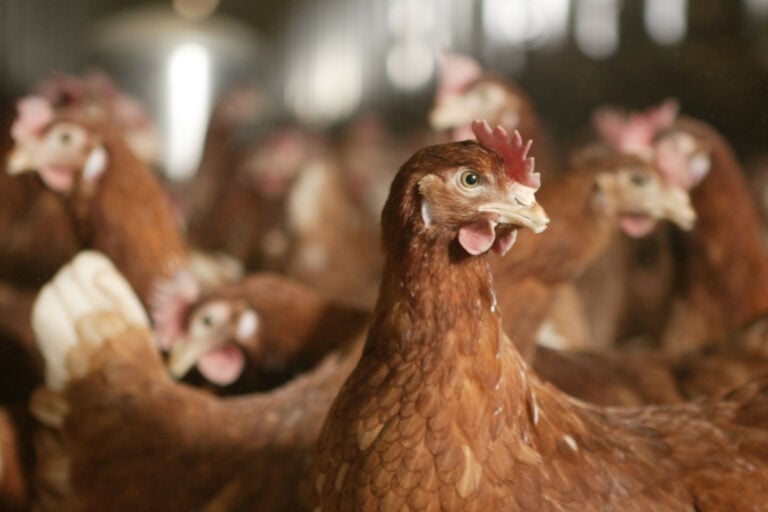June 23, 2025 | 16:02 GMT +7
June 23, 2025 | 16:02 GMT +7
Hotline: 0913.378.918
June 23, 2025 | 16:02 GMT +7
Hotline: 0913.378.918

In terms of production and egg quality, the Hy-Line Brown strain stood out. Photo: Michel Zoeter.
The study, published in the journal Poultry Science, carried out by the Department of Poultry Science at North Carolina State University, evaluated genetic strains in cage-free environments, as the US egg sector moves away from cage production.
Figures from last year show that cage-free eggs are becoming increasingly popular due to growing concerns about animal welfare and accounted for around 40% of eggs sold.
Transitioning strains that were selected for caged production may elicit challenges in their adaptation to alternative systems, so it cannot be assumed that egg production and quality parameters are comparable in various environments, the researchers said.
White birds are historically associated with caged production while brown strains typically occupy cage-free, pasture-raised or free-range systems.
Influence of genetic strain on egg production and quality
In the study, each strain was housed in a separate 10×4 foot (about 3×1.2 m) pen, equipped with a roost, a 3-rung ladder perch and 4 nesting boxes.
The study evaluated the influence of genetic strain on egg production and quality in a cage-free environment. Hy-Line W-36 White, H+N White, Hy-Line Brown and Bovan Brown laying hen strains were evaluated through a number of egg production and quality parameters through the entirety of a lay cycle (72 weeks).
To measure production, 18 eggs were randomly collected from each strain, sorted and separated into 3 groups to undergo analysis. The research examined characteristics such as shell strength, yolk colour and USDA grade standard.
Results
The study found H+N White hens were the lowest producing strain, demonstrated by producing the least number of eggs per hen, having the lowest hen-day egg production (p<0.0001), producing the fewest USDA grade A eggs (p=0.0023) and the most check eggs (p=0.0006).
Lead author Bhavisha Gulabrai said: “We think they probably had a more difficult time adjusting to the cage-free system. Visually and anecdotally, white strains are more flighty and our H+N White strain remained pretty flighty throughout the entire 72 weeks.”
However, the research found that Bovan Browns were the least efficient strain as this strain consumed the most feed and had the lowest overall feed conversation ratio (p<0.0001).
Overall, both white strains demonstrated poorer egg quality compared to brown strains. Hy-Line W-36 White hens had the lowest albumen height, Haugh unit-score, yolk colour and yolk weight (p<0.0001).
Better suited to cage-free production
In conclusion, the Hy-Line Brown hens may be better suited for cage-free production based on overall greater egg production and quality metrics compared to the other 3 strains.
The research demonstrates that genetic strain did influence cage-free laying hen performance.
Commenting on the results, Gulabrai said: “When we looked at production and egg quality, the Hy-Line Brown strain did better than the 3 other strains used in the study. They just had better egg production and better egg quality metrics compared to the 3 other strains,” she added.
(Poultryworld)
![Turning wind and rain into action: [9] Digitizing hydrometeorological data in response to climate change](https://t.ex-cdn.com/nongnghiepmoitruong.vn/608w/files/news/2025/06/17/z6704423696987_15fd32ffc26d590d204d520c9dac6786-nongnghiep-165943.jpg)
(VAN) Farmers have begun accessing hydrometeorological applications to adjust their cropping schedules, aiming to ensure productivity and adapt to climate change.
![Turning wind and rain into action: [8] Real-time salinity detection and early warning technology](https://t.ex-cdn.com/nongnghiepmoitruong.vn/608w/files/news/2025/06/17/z6704423696987_15fd32ffc26d590d204d520c9dac6786-nongnghiep-151127.jpg)
(VAN) Thanks to the integration of modern hydrological-hydraulic models, remote sensing technologies, and artificial intelligence, the accuracy of hydrological forecasting has significantly improved.
![Turning wind and rain into action: [7] Early disaster warnings help marine farmers minimize losses](https://t.ex-cdn.com/nongnghiepmoitruong.vn/608w/files/news/2025/06/17/z6704423696987_15fd32ffc26d590d204d520c9dac6786-nongnghiep-142942.jpg)
(VAN) In recent years, thanks to early disaster warnings and forecasting, marine farmers in Khanh Hoa province have been able to reduce risks and losses, thereby improving production efficiency.
![Turning wind and rain into action: [6] ‘Four on-the-spot’ disaster management software](https://t.ex-cdn.com/nongnghiepmoitruong.vn/608w/files/news/2025/06/17/e5a48259d6a262fc3bb3-nongnghiep-183800.jpg)
(VAN) By simply activating the scenario on the disaster management software, the relevant authorities immediately know how many households need to be evacuated, where to evacuate them to, and by what means of transportation…
![Turning wind and rain into action: [5] Hue applies modern technology in disaster forecasting](https://t.ex-cdn.com/nongnghiepmoitruong.vn/608w/files/news/2025/06/17/z6704423696987_15fd32ffc26d590d204d520c9dac6786-nongnghiep-093938.jpg)
(VAN) In Hue city, modern technology has recently been applied in meteorological and hydrological forecasting and warning, helping to reduce the damage caused by natural disasters.

(VAN) A cutting-edge farming technique being implemented on an experimental ranch in Arizona's Sonoran Desert has already saved a billion gallons of water over five years, according to Civil Eats.